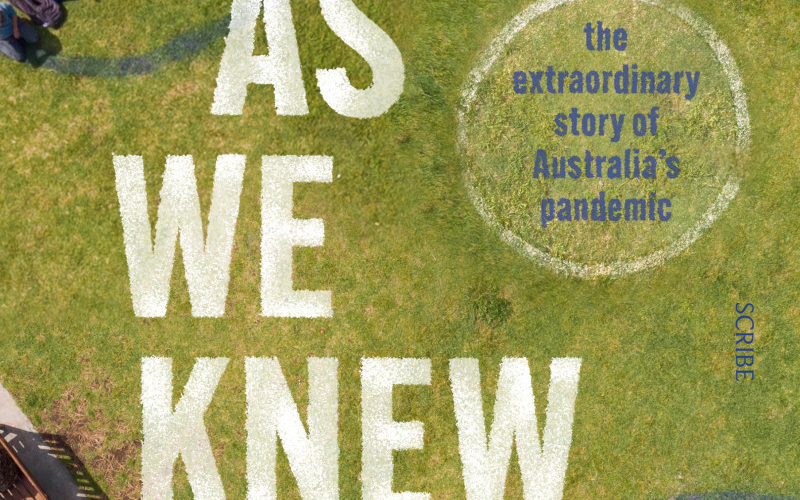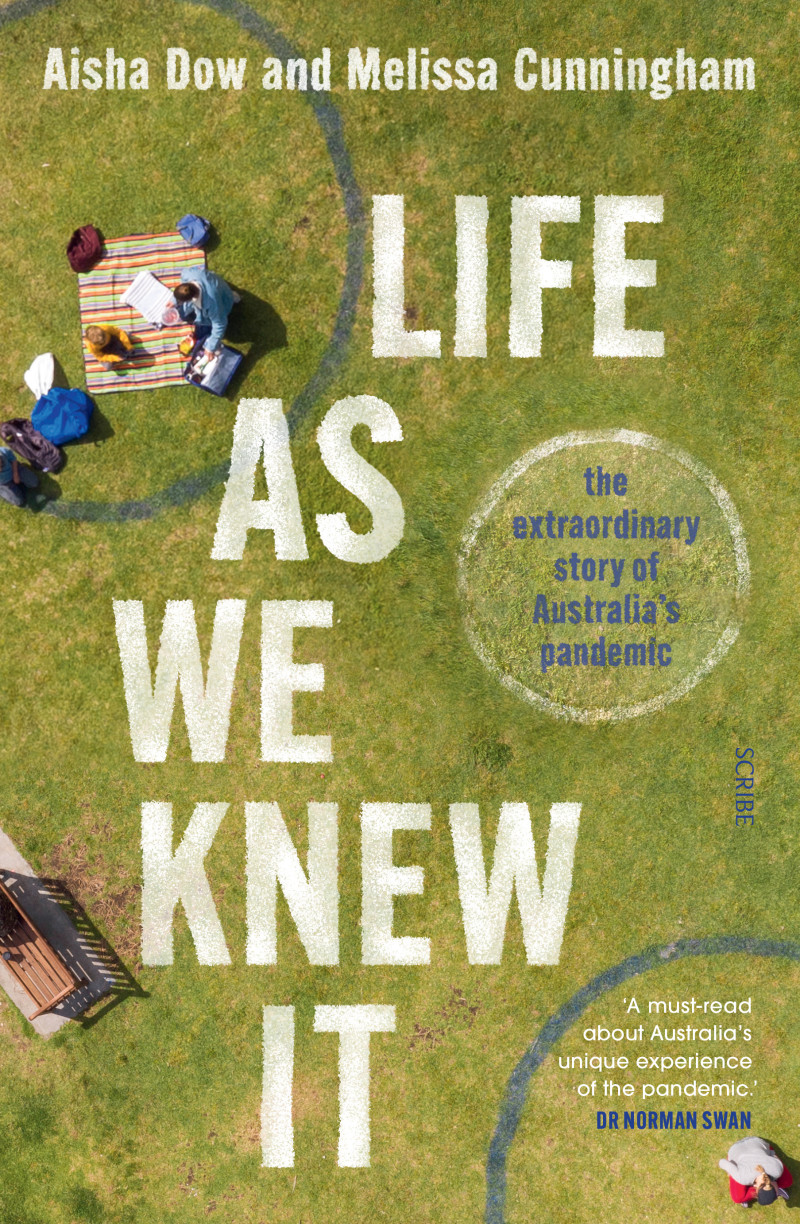
- Free Article: No
- Contents Category: Pandemic
- Review Article: Yes
- Article Title: Far from over
- Article Subtitle: An insider take on the pandemic
- Online Only: No
- Custom Highlight Text:
In October 2014, an article by health reporter Aisha Dow appeared in Melbourne’s Age newspaper titled ‘Deadly flu pandemic could shut down Melbourne’. It began with a dystopian vision of Australia’s second most populous city plunged into a Spanish flu-like crisis:
- Featured Image (400px * 250px):

- Alt Tag (Featured Image): Ben Brooker reviews ‘Life As We Knew It: The extraordinary story of Australia’s pandemic’ by Aisha Dow and Melissa Cunningham
- Book 1 Title: Life As We Knew It
- Book 1 Subtitle: The extraordinary story of Australia’s pandemic
- Book 1 Biblio: Scribe $35 pb, 325 pp
- Book 1 Cover Small (400 x 600):

- Book 1 Cover (800 x 1200):

Reading this piece as the first years of the pandemic recede into memory in only the way the recent past can is to be struck by its far-sightedness. So prescient does it seem now, as Dow and co-writer Melissa Cunningham point out in their new book on Australia’s experience of Covid-19, that conspiracy theorists latched onto it as ‘evidence’ that the pandemic was manufactured by the authorities (presumably it makes perfect sense to the deranged minds of conspiracy theorists that the mainstream media, which they claim to distrust, would disseminate details of such a ‘plandemic’ years in advance).
There may not have been 10,000 deaths in Victoria during the pandemic’s first wave – the deadliest by far would prove to be the fourth, or Omicron, wave, which began in late 2021 – but much of what Dow prophesied did come to pass. For this reason, she is perhaps uniquely positioned to write the story of the pandemic in Australia, which, though far from over – the nation is facing its eight wave and yet another ‘Covid summer’ as I write – seems ripe for the telling.
Life As We Knew It provides, for the most part, an insider’s perspective of the pandemic, the authors’ reportage peppered with recent interviews with premiers, state and federal ministers, and a range of health experts. As you would expect, state chief health officers – those formerly faceless apparatchiks who acquired minor celebrity status during the Covid years, attracting everything from eroticised fandom to death threats – feature heavily. Dow and Cunningham’s brisk, journalistic prose is efficient, if a little colourless, and assembles a complex picture from a wealth of research (which, unfortunately, is undercut by the absence of endnotes). Testimony from ordinary people – shelf-stackers, tradies, and the like – introduces a balancing, ‘people’s history’ flavour, reminding the reader that, while Australia’s pandemic response was orchestrated by those with the most power, its effects were felt by those with the least.
The book is, perhaps necessarily, a patchwork. Depending on your postcode, Australians’ individual experiences of the pandemic’s first waves varied widely. Dow and Cunningham reflect this by wisely dedicating chapters to each state and territory, attesting that – just as with the 1919 Spanish flu pandemic – Federation is both a uniting and dividing construct. In South Australia, where I lived at the time, the pandemic barely registered for most of the population. In Western Australia, which has long flirted with the idea of secession, the state government’s lengthy border closures saw Covid kept more or less at bay for years, and then-premier Mark McGowan soar to extraordinary levels of public approval.
In the east, of course, it was a different story. Sydney’s ‘gold standard’ of infrequent lockdowns and superior testing and tracing proved unsustainable, especially during the Ruby Princess cruise ship debacle, when dozens of Covid-infected passengers were allowed to disembark at Circular Quay, leading to hundreds of further cases. It was Victoria, though, that would emerge as the epicentre of Australia’s pandemic, enduring the longest lockdown of any major city in the world – a gruelling 262 days – in 2021.
Dow and Cunningham also paint another picture of the virus in Australia, one defined less by state borders than those which demarcate the comfortable from the underprivileged. Health economist Stephen Duckett describes a ‘tale of two pandemics’ whereby the physically, psychologically, and emotionally stable were able to experience Covid as a manageable disruption to their lives while those living in disadvantaged and often culturally diverse suburbs were devasted.
Of all of Australia’s pandemic mistakes, the failure to translate Covid and vaccine messaging into the languages of the country’s many migrant communities was surely among the most consequential, leaving culturally and linguistically diverse families vulnerable to disease, economic precariousness, and the kind of over-policing seen in the hard lockdown of nine public housing towers in Melbourne in mid-2020.
The pandemic’s toll on young people and the elderly was similarly stark and shocking. Teenagers and young adults, cut off from schools and other social outlets for extended periods of time, experienced record levels of mental health disorders, self-harm, and suicidal ideation – a ‘shadow pandemic’ in the words of youth mental health expert Patrick McGorry, and one that is expected to worsen over the next few years. Not many Australians could forget, at the opposite end of the age scale, the horrific scenes – body bags on gurneys, family members banging forlornly on windows – which emerged from the country’s broken aged care system as the virus made a mockery of inadequate health and staffing protocols.
So, in the final analysis, how did the country fare in its pandemic response? The answer is undoubtedly mixed. The authors give credit to the Morrison government for acting swiftly in the early days of the pandemic to close the borders, introduce quarantine and isolation requirements, and provide economic support for workers and businesses. Looking back, it is easy to forget now just how radical some of these interventions were, upending decades of neoliberal ‘small government’ shibboleths virtually overnight.
On the other hand, the federal government’s mismanagement of the acquisition and rollout of vaccines (‘It’s not a race’) and failure to order enough rapid tests showed a side of the country’s pandemic response that was chaotic, miserly, and bereft of forethought. Such missteps contributed to the perception that Scott Morrison was inept at dealing with crises – as his disastrous handling of the Black Summer bushfires had proven – but Dow and Cunningham let the former prime minister off the hook in surprisingly softball interviews. Morrison’s anodyne answers reveal little more than what we already knew – that few politicians before or since possess the same skill for self-aggrandisement where there is credit to be claimed, and deflection onto others where there is criticism to be made.
The accounting, however, as Dow and Cunningham make clear, is, like Covid itself, far from over. Doherty Institute director Professor Sharon Lewin tells the authors that, relative to other Western countries, Australia’s collecting of data on the health outcomes of Covid and long Covid has been poor. We still don’t know, among other things, how effective Victoria’s harsh lockdown rules were, or exactly which measures contributed to the state’s remarkable success in crushing its second wave in 2020. The national inquiry currently underway, the final report of which is due by the end of September next year, will more than likely fill in some of the blanks. But it remains to be seen whether, as the Albanese government is promising, the report will improve the nation’s preparedness for future pandemics.
We were, after all, warned once before.


Comments powered by CComment